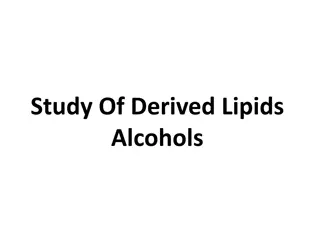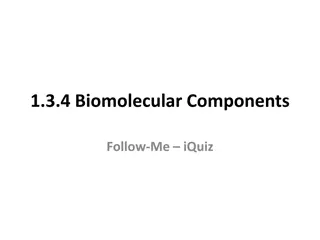Understanding Lipids: Nature's Flavor Enhancers
Lipids, a category of organic compounds, are essential for enhancing flavors in food. They contain carbon, hydrogen, and oxygen but do not dissolve in water. Lipids come in three general types - triglycerides, phospholipids, and sterols. They consist of glycerol and fatty acids, with variations like monoglycerides and diglycerides. Fatty acids are organic molecules with a carbon chain and carboxyl group. Phospholipids, another type of lipid, have unique properties that allow them to mix with both water- and fat-based substances. They play a crucial role in transporting fats across cell membranes and maintaining the consistency of food products like mayonnaise.
Download Presentation

Please find below an Image/Link to download the presentation.
The content on the website is provided AS IS for your information and personal use only. It may not be sold, licensed, or shared on other websites without obtaining consent from the author. Download presentation by click this link. If you encounter any issues during the download, it is possible that the publisher has removed the file from their server.
E N D
Presentation Transcript
Lipids: Natures Flavor Enhancers
Lipids a category of organic compounds that are insoluble in water and have a greasy feel.
Pringles Calories Fat Satur- ated Fat Cost Regular Pringles 150 9 2.5 $1.00 Light Pringles 70 0 0 $2.58
Terms used for lipids: Fat Oil Shortening Grease Cholesterol
Lipids, like carbohydrates, contain carbon, hydrogen, and oxygen. But lipids do not provide structure to food products and they cannot dissolve in water.
Three general types of lipids in foods and the human body Triglycerides Phospholipids Sterols
Most lipid molecules found in foods and the body have two basic parts. The base or core is a glycerol molecule called glycerides. The second part of most molecules is called a fatty acid.
Glycerides 1sttype of lipid Monoglycerides is a glycerol with one fatty acid attached at the site of a hydroxyl group. Diglycerides is a glycerol with two fatty acids attached. Triglycerides have a fatty acid joined at each of the three hydroxyl sites.
Fatty Acids are organic molecules that consist of a carbon chain with a carboxyl group at one end.
Phospholipids- 2ndtype of lipid A second basic type of lipid that has a glycerol base with two fatty acids AND a phosphorus- containing acid attached. The fatty acids are soluble in water. This allows phospholipids to mix with both water- based and fat-based substances.
Phospholipids- 2ndtype of lipid Phospholipids help carry fats back and forth across cell membranes into the water-based fluids. In food products, phospholipids keep foods like mayonnaise from separating.
Sterol 3rdtype of lipid Complicated molecules derived or made from lipids. Examples: cholesterol, vitamin D, steroid hormones. Cholesterol is a part of every cell in the human body.
To understand the effects of lipids in food mixtures, you need to understand the ways lipids are categorized.
Lipids are grouped according to: molecular structure physical state at room temperature dietary sources
Molecular Structure (category) One way to categorize lipids is by how saturated their carbon chains are with hydrogen atoms.
Molecular Structure (category) Each carbon atom is capable of forming 4 bonds. A carbon atom can bond twice to another carbon atom. This is called a double bond. Fatty acids will have 0, 1, or multiple double bonds.
Molecular Structure (category) When fatty acids have the maximum number of hydrogen atoms, they are saturated. Examples: butter, shortening, coconut oil
Molecular Structure (category) Fatty acids that have one double bond in the carbon chain are called monounsaturated. Examples: olive oil, almonds, walnuts, canola oil
Molecular Structure (category) Polyunsaturated fatty acids have two or more double bonds in the carbon chain. Each double bond bends the fatty acid chain. Bends make it difficult for the molecules to pack together tightly. Examples: safflower, sunflower, and corn oil
Physical State (category) Lipids that are solid at room temperature are called fats. Lipids that are liquid at room temperature are called oils.
Physical State (category) Hydrogenation adding hydrogen atoms to an unsaturated fat to increase its saturation level.
Physical State (category) Advantages of hydrogenated vegetable oil: Longer shelf life than oil Greater stability than lard Costs less than lard Faster dissolving and setting properties in chocolate
Food Source (category) Milk fats come from the milk of cows or goats. Lauric acids come from palms of coconut. Vegetable butters come from seeds of tropical plants. Oleic-linoleic acids come from corn, peanuts, sunflowers, or olives
Food Source (category) Linolenic acid comes from soybeans and wheat germ. Animal fats are found in meat and poultry. Marine oils come from fish.
Functions of Lipids in Food Preparation Transfer heat Tenderize Aerate (add air to a batter) Enhance flavor Lubricates Liquids in emulsions
Functions of Lipids in Food Preparation Transfer heat lipids will continue to increase as heat is added; every lipid has a smoke point and a flash point. Smoke point temperature at which the fatty acids begin to break apart and produce smoke. Flash point temperature at which lipids flame.
Functions of Lipids in Food Preparation Tenderize fats tend to shorten the long protein strands of flour of most baked goods, thereby, tenderizing the baked good.
Functions of Lipids in Food Preparation Aerate (add air to a batter) saturated fat has the ability to allow tiny air pockets to form when batters are beaten sufficiently. If over-beaten, fat could melt and then air pockets are lost.
Functions of Lipids in Food Preparation Enhance flavor fats add flavor, helps transfer and intensify flavor. Examples: Butter adds flavor to bread; onions and garlic cooked in fat will be stronger than if cooked in a broth base.
Functions of Lipids in Food Preparation Lubricates makes food seem moister and easier to chew. Examples: Marbling in meat; mayonnaise spread on sandwiches
Functions of Lipids in Food Preparation Liquids in emulsions usually one of two liquids in an emulsion a mixture that contains a lipid and a water-based liquid. Examples: mayonnaise; bottle salad dressings
Lipids in Your Diet - Functions Concentrated source of energy 9 calories / gram Cell production cell walls made of lipids and proteins
Lipids in Your Diet - Functions Temperature regulation fatty tissue insulates and holds body warmth Helps transport vitamins some vitamins needs fat to be transported
Essential Fatty Acids Fatty acids that the body cannot produce: Linoleic acid Linolenic acid Both of these are polyunsaturated Both are found in most plants and fish oils Essential for growth and development
Role of Cholesterol Used to build cell membranes it is a rigid molecule that helps solidify cell walls; adds stability to cell s structure Body makes cholesterol from lipids
Atherosclerosis Results when there is too much cholesterol in the blood Too much blood cholesterol causes deposits called plaque. The rigidity of the cholesterol plaque deposits on the walls of arteries hardens the arteries. This hardening is called atherosclerosis.
Lipoproteins These are clusters of lipid and protein molecules. Transports cholesterol throughout the body LDL (Low-density lipoproteins) carry cholesterol from the liver HDL (High-density lipoproteins) find unneeded cholesterol and return it to the liver. LDL and HDL work together to keep cholesterol in balance.
Lipoproteins Too much LDL can clog arteries, increasing risk of heart attack or stroke. High levels of HDL seem to help protect against heart attack and stroke. Important recommendation eat a reasonable amount of the right kinds of lipids.























